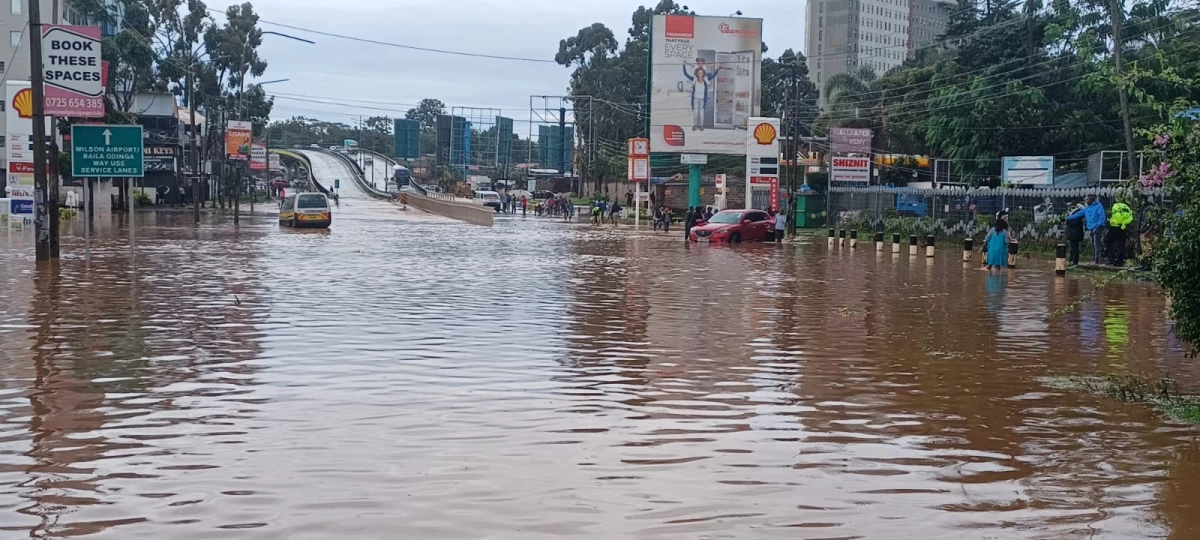OPINION: Nairobi's deluge is a rallying call to collectively design a more resilient city

A flooded road in T Mall roundabout, Langata.
The current deluge in Nairobi has been a harsh reminder of our city's vulnerability. Torrential downpours transformed streets into raging rivers, homes into islands, and lives into a desperate scramble for safety.
As the floodwaters recede, a crucial question remains – how do we build a Nairobi that can withstand the increasing frequency and intensity of these climate shocks?
As an experience designer with a focus on the built environment, I spend a lot of time thinking about the spaces we inhabit, particularly how they can better serve our needs in the face of unforeseen challenges. Nairobi's recent floods highlight a crucial point – our cities are living, breathing entities. Just like us, they need the capacity to endure natural assaults.
Traditionally, flood mitigation strategies have focused heavily on engineering solutions – higher walls and stronger drains. While these are essential, they often address the symptoms, not the root causes.
Therefore, there is a real need for a more holistic approach. Here in Nairobi, we have a unique opportunity to learn from these floods and become a leader in resilient urban design.
We have witnessed how flood-prone areas coupled with improper drainage systems turn every downpour into a potential threat. Narrow streets become impassable, and information on evacuation routes or available shelters may be scarce.
These everyday experiences hold valuable insights about the present state of the problem.
In designing for the citizen's experience (CX), we don't just focus on aesthetics; we ensure solutions are human-centered, intuitive, and effective. Imagine flood barriers that double as community gathering spaces, or early warning systems that deliver clear, actionable alerts in multiple languages.
Additionally, design evacuation routes that are accessible to everyone, including those with disabilities. By prioritizing the needs and experiences of residents, we can champion solutions that are not just functional, but also socially responsible and culturally appropriate.
A Nairobi where our neighborhoods are living sponges, soaking up excess rainwater instead of channeling it towards overflowing drainage systems. This could involve incorporating permeable pavements allowing water to seep back into the ground, or bioswales – landscaped areas that act as natural filters for rainwater runoff.
These solutions not only reduce flood risk but also create a more verdant and aesthetically pleasing cityscape.
To that end, resilience demands a concerted effort – collaboration between residents, meteorologists, engineers, UX designers etc. al. Residents can share their firsthand experiences of flooding, highlighting vulnerable areas and identifying potential weak points in the city's infrastructure.
Meteorologists can provide data on historical flood patterns and future projections. Engineers can then translate this knowledge into practical solutions – elevating buildings in high-risk zones, creating green spaces that double as natural drainage channels, or designing homes with flood-proofing measures.
Technology is a complementary tool in the resilience strategy. Providing citizens with real-time flood risk information based on their location and historical data can leverage the effectiveness of our existing social networks.
Personalized information with preparedness tips, evacuation routes, and even connections to emergency services during a crisis can be shared through platforms like WhatsApp. The key here is to ensure technology facilitates information accessibility, including its availability in multiple languages to reach all segments of the population.
Nairobi isn't alone in these challenges. Cities across Kenya, from Kisumu to Mombasa, grapple with similar issues. A knowledge-sharing network where cities can learn from each other's experiences.
Mombasa, with its experience in coastal flooding, could share best practices, and Kisumu, a leader in rainwater harvesting techniques, could offer insights on creating green infrastructure.
Evidently, the way we build and interact with our cities needs to evolve. Cities are not just places to live, but vibrant, thriving communities.
By embracing a collaborative approach, leveraging technology for effective communication, and practicing a culture of preparedness, restoring the City of Cool waters, and pace set the transformation of other African cities, into urban spaces that can weather any storm, both literally and figuratively. Let's start the conversation together.
The writer, Leanne Munyori, is Service Designer at MarathonXP
Want to send us a story? SMS to 25170 or WhatsApp 0743570000 or Submit on Citizen Digital or email wananchi@royalmedia.co.ke
Comments
No comments yet.


Leave a Comment